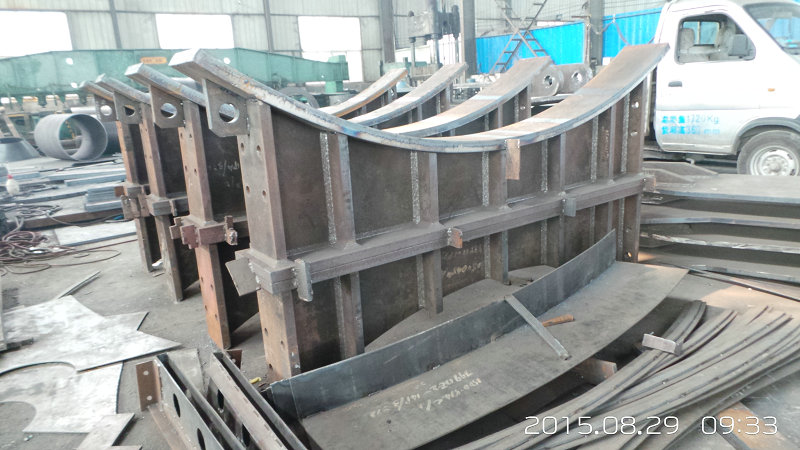CNC Machining Carbon Steel Parts
Carbon Steel Is An Iron-Carbon Alloy With Carbon Content Ranging From 0.0218% To 2.11%. It Also Contains a Small Amount Of Silicon, Manganese, Sulfur And Phosphorus. Generally, The Higher The Carbon Content In Carbon Steel, The Higher The Hardness And Strength, But The Lower The Plasticity.
Classification
(1) Carbon Steel Can Be Divided Into Three Types According To Its Use: Carbon Structural Steel , Carbon Tool Steel And Free Cutting Structural Steel . Carbon Structural Steel Can Also Be Divided Into Engineering Construction Steel And Machine Manufacturing Structural Steel .
(2) According To The Smelting Method, It Can Be Divided Into Open-Hearth Steel And Converter Steel .
(3) According To Deoxidization Method, It Can Be Divided Into Boiling Steel (F ), Killed Steel (Z), Semi-Killed Steel (B) And Special Killed Steel (TZ).
(4) According To Carbon Content, Carbon Steel Can Be Divided Into Low Carbon Steel (WC < 0.25%), Medium Carbon Steel (WC 0.25% – 0.6%) And High Carbon Steel (WC > 0.6%).
(5) According To The Quality Of Steel, Carbon Steel Can Be Divided Into Ordinary Carbon Steel (Containing Higher Phosphorus And Sulphur), High Quality Carbon Steel (Containing Lower Phosphorus And Sulphur), High Quality Steel (Containing Lowest Phosphorus And Sulphur).
Carbon Structural Steel
Brand: Example q235-a.f, Which Means Qs=235 Mpa.
Note: q Is Yield Strength a Quality Grade (Abcd Grade 4), f Boiling Steel.
Features: Low Price, Excellent Process Performance (Such As Weldability And Cold Formability).
Application: General Engineering Structure And Common Mechanical Parts. For Example, q235 Can Be Used To Make Bolts , Nuts , Pins , Hooks And Less Important Mechanical Parts, As Well As Threaded Steel , Profiled Steel , Reinforcing Steel In Building Structures.
High Quality Carbon Structural Steel
Brand: Such As 45, 65Mn, 08F.
Name Note: Indicates Directly The Ten Thousand Percent Carbon Content Of Metals.
Application: Non-Alloy Steel For Manufacturing Important Mechanical Parts Is Usually Used After Heat Treatment.
Common Steel Grades And Uses:
08F Steel : Low Carbon Content, Good Plasticity, Low Strength, Used For Stamping Parts , Such As Automobile And Instrument Housing;
20 # Steel : Good Plasticity And Weldability. Used For Parts With Low Strength And Carburized Parts , Such As Hood , Welding Container , Small Shaft , Nut , Washer And Carburized Gear .
45 # Steel And 40Mn Steel : Which Has Good Comprehensive Mechanical Properties After Quenching And Tempering, Is Used For Mechanical Parts With Large Force, Such As Gears , Connecting Rods , Machine Tool Spindles , Etc.
60 # Steel And 65Mn Steels : Have High Strength And Are Used To Manufacture Various Springs , Wheel Flanges And Low-Speed Wheels .
Carbon Tool Steel
Brand: For Example, t12 Steel Represents Wc = 1.2% Carbon Tool Steel.
Name Note: t Plus Thousands Of Carbon Content Of Metal.
Characteristic: It Belongs To Eutectoid Steel And Hypereutectoid Steel. It Has High Strength, Hardness And Good Wear Resistance. It Is Suitable For Manufacturing Various Low-Speed Cutting Tools.
Common Steel Grades And Uses:
T7 , T8 : Making Parts That Bear Certain Impact And Require Toughness. Such As Hammer , Punch , Chisel , Woodworking Tools , Scissors .
T9 , T10 , T11 : Manufacture Tools With Low Impact, High Hardness And Wear Resistance. Such As Taps , Small Drills , Dies , Hand Saw Blades .
T12 , T13 : Making Tools That Are Not Impacted. Such As Files , Scrapers , Razors , Measuring Tools .
Cast Steel
Brand: For Example, ZG200-400, Which Means Cast Steel With Qs = 200 Mpa And Qb = 400 Mpa.
Property: Casting Property Is Worse Than Cast Iron, But Mechanical Property Is Better Than Cast Iron.
Application: Mainly Used For Manufacturing Complex Shape, High Mechanical Properties, But It Is Difficult To Forge And Other Important Mechanical Parts, Such As Automobile Gearbox Housing , Locomotive And Vehicle Coupler And Coupling.
Influence Factor
Manganese : About 0.25%~0.80%. Solid Solution Strengthening, Removal Of FeO, Reduction Of Brittleness Of Steel, And Synthesis Of MnS With Sulfurization Can Alleviate The Harmful Effect Of Sulfur. It’s Good.
Silicon : About 0.10%~0.40%, Solid Solution Strengthening; Except For The Bad Effect Of FeO On Steel Quality, It Is Beneficial.
Sulphur : FeS And Fe Form Eutectic With Low Melting Point (Melting Point Is 985 Degrees Celsius), Which Leads To Brittle And Cracking Of Steel During Hot Working At 1000-1250 Degrees Celsius. Harmful.
Phosphorus : Strength And Hardness Are Improved, But Plasticity And Toughness Are Reduced, “Cold And Brittle”. Harmful.
